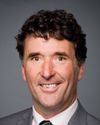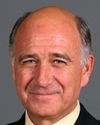Thank you very much, Mr. Chair.
Thank you all for coming. I'm really very impressed and gratified that there's such an interest in the Global Fund and what we have to share with you. Thanks for the invitation. Thanks also to Svend Robinson, who has been working with me in the Global Fund and who is very well known to many of you.
In fact, I was before this committee together with our then executive director Richard Feachem five years ago, in 2005. I know that a few of you were present at that time. That gives me an opportunity to describe to you what has happened over the last couple of years. I think it's a very impressive story.
The Global Fund was created in 2002, meaning that when I was here in February 2005, we were three years old. Now we are eight years old. The results of what has happened in that period of time are really quite impressive.
When I was here in 2005, the Global Fund had $6 billion in contributions from the donors. Now we have $22 billion overall from public and private donors. At that time, we had approved programs worth $2.4 billion. Now we have $19.3 billion worth of programs in 140 countries on all three diseases—AIDS, tuberculosis, and malaria.
However, the most important thing is what has actually happened with this money. Have we been able to achieve real results that are affecting the lives of people around the world?
Here are a few highlighted figures. At that time, 2005, we supported 50,000 people on antiretroviral treatment. Nowadays we support 2.5 million people on antiretroviral treatment around the world. At that time, we had helped countries distribute 2.7 million impregnated mosquito nets to prevent malaria. Up to now, we have distributed 104 million mosquito nets. At that time, we had provided treatment for tuberculosis for 250,000 people. Up to now, more than six million people have received effective tuberculosis treatment.
You can see the trajectory of the financial support that enabled countries to implement very impressive programs. It has been calculated conservatively that five million people are alive today who would otherwise have died already from these diseases, and the number is increasing by 3,000 lives per month.
Looking at the bigger picture for these three diseases, we are really talking about what we are achieving in terms of reaching the health-related millennium development goals. Very briefly, there has been very impressive progress on malaria. Among the three diseases, this is the easiest disease to prevent and to treat because, with the combination of bed nets and effective treatment, you can lower mortality from malaria by 50% or more.
That is exactly what has been happening. We have a number of countries in Africa—Ethiopia, Eritrea, Burundi, Rwanda, Tanzania—in which we see declines of mortality from malaria of 50% and more. It is so successful that not only do we believe, together with the World Health Organization and others, that we can reach the millennium development goal on malaria, but we might be moving toward the elimination of malaria as a public health problem in many countries around the world. That would be a major achievement, of course.
When it comes to tuberculosis, again there are declines in tuberculosis incidence in many countries. We believe we are on track to reaching the millennium development goal on tuberculosis.
The most complex of the three diseases is HIV/AIDS. While I said that we have 2.5 million people on treatment, that is a huge success. Ten years ago, hardly anybody in Africa was receiving treatment; now, 42% of all people in Africa with AIDS are receiving effective treatment. However, we still have a way to go to achieve universal access and a broader decline in mortality from AIDS, so we will have to redouble our efforts to reach those goals.
Let me say one word about the relationship between the three diseases and maternal and child health, because that is a very important topic. We applaud the Canadian government for putting it high on the agenda of the upcoming G-8 summit here in Canada, but we want to make the point that 51% of women in Africa are still dying from AIDS, tuberculosis, and malaria. They are also dying from causes that are directly related to childbirth; still, the diseases play the biggest role, and therefore we have a major impact on maternal mortality, directly and indirectly.
We are also providing support for contraceptives, for antenatal clinics, and for sexual and reproductive health. We already invest a lot into maternal and child health; in fact, we believe that 37% of all our resources go into child and maternal health. I think that is a very important point as Canada, together with the other G-8 countries, considers the way forward in making more progress on these very important issues.
Canada has been a very strong supporter of the Global Fund from the beginning. Currently, the vice-chair of the board is Dr. Loevinsohn, from CIDA. Canada is the eighth-largest donor to the Global Fund. It is currently providing $150 million per year.
We are in a replenishment period. That means that every three years the donors come together for replenishment conferences. The next one will happen in New York on October 5, under the chairmanship of Secretary-General Ban Ki-moon.
We have asked the donors to consider three scenarios that need significant increases in the contributions to the fund, increases of either $13 billion, $17 billion, or $20 billion. That's what the donors are currently considering, which means that increases are required. I'd say our major donors would need to increase by 50% if we want to maintain the momentum toward the achievement of the millennium development goals. We have a real chance and a real opportunity this year, but it would require a significant increase from our main supporters, including Canada.
There is good news from some donors. Japan has just increased its contribution for this year by 27% and the U.S. has increased consistently by 30% over the last few years, so we have positive signals, but we need this momentum.
I wanted to show you a short video that shows you some of the main supporters of the Global Fund. They helped to create the Global Fund and they still maintain support for the Global Fund. I would be glad if we could listen to a few key voices here.






